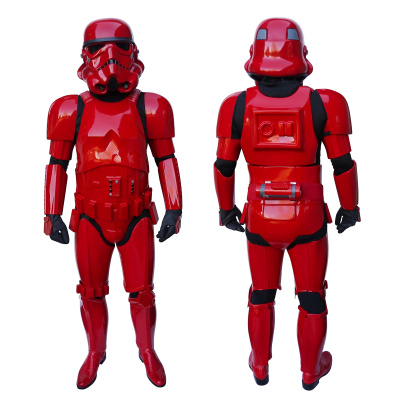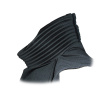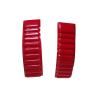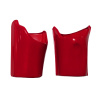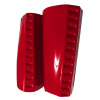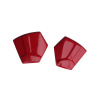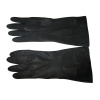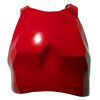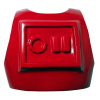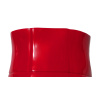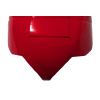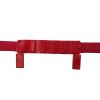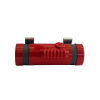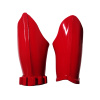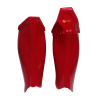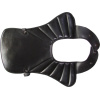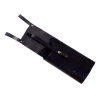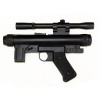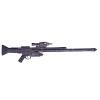Crimson Stormtrooper
Visit the Gallery for this Costume for more models and parts views.
Model TX-95970, Photo by Jacob Roush-Wright
Description: Crimson Stormtrooper
Prefix: TX
Detachment: Spec Ops Detachment
Context: The New Essential Guide to Weapons and Technology; Star Wars: The Visual Dictionary
This Visual Guide has been reviewed by the detachment staff and the LMO team and is certified for use as a minimum approval guideline for GMLs. GMLs are free to approve this costume type.
This is a visual guide used for 501st costume approval, not a how-to for construction. Construction details are found at the costume's Detachment website. Measurements provided here are generalized, and not criteria for approval. All 501st costumes are proportionate to the wearer in terms of size, fit, and scale. During evaluation, both text and images (CRL and Reference) must be considered. When in doubt about a feature of a submitted costume, GMLs should post questions in the Legion forum's DL/GML peer review section.
Required Costume Components
The following costume components are present and appear as described below. For 501st membership only the requirements in black need to be met. This Detachment defines additional, optional costuming details listed in blue and red. Please visit the Detachment website for more details on these options.
Helmet
- Lenses must be sufficiently dark enough to obscure the costumer's eyes. They are either flat or bubbled. Acceptable colors are black, smoke, or dark green.
- The body of the "ears" are gray. The bars have three or four bumps and can be left the same color as the body or painted black.
- The frown must have 8 teeth cut out and any coloring must not leave the indented area.
- Acceptable colors are black and gray.
- Black mesh must be used to obscure the face of the wearer.
- The tube stripes are black in color and may number between 9 and 16 per side with the curve bends extending backwards. These can be either hand painted or decals.
- Vocoder (vertically ribbed chin detail) is black.
- The aerators (cylinders on either side of the vocoder) are black, and screening is silver.
- The interior of the aerator can either be white, silver or black.
- Traps (trapezoids on dome of helmet) and tears (area beneath the corners of eye lenses) can be hand painted or decals.
- Acceptable color is gray with black outlines and highlights. Tears have vertical black lines. Rear traps do not have vertical black lines.
OPTIONAL Level two certification (if applicable):
- Ears shall have three screws per side, one above and one below the ear bar and one at the base of the helmet. Screws are slotted, flat topped, countersunk and painted red.
- Ear bars have four bumps only, not three.
- Traps/tears shall be hand painted or decals in gray and shall have the correct details similar to the ANH TK.
- Correct 'Hovi mic' aerator tips.
- The screen in the aerator tips shall be painted silver and the interior of the aerator tip shall be painted white or black.
- Screens used shall be of a wide type mesh.
- Neck trim shall be an S-type profile rather than a U-type profile.
Neck Seal
- Black with horizontal ribs, fitted to the wearer, and extending from the base of the neck to conceal the entire neck.
Under Suit
- Black non-textured material, either one-piece or two-piece construction with no visible zippers or logos.
Shoulder Straps
- These shall be securely mounted in front and may free float in the back. They can be affixed with rivets, Velcro or adhesive.
- The rear tab of the strap is optional and may or may not be present.
OPTIONAL Level two certification (if applicable):
- No visible rivets are allowed to secure the straps in the front.
- These shall need to be held down in the back with black elastic band to the black fabric that connects/ bridges the chest and back armor.
- These shall be glued in front.
- The rear tab of the strap shall be removed same as the TKs seen in ANH movie.
Shoulder Armor
- One on each shoulder.
- The shoulder bells are considered effectively symmetrical. They can be worn interchangeably on the left and right shoulders.
- Shoulders have a black elastic strap that wraps around the inside of the bicep.
OPTIONAL Level two certification (if applicable):
- There should be a minimal gap between the shoulder armor and chest/back plate.
Biceps
- Biceps are fully closed.
- Overlap construction is only allowed for kits that come with the cover strip molded into the part.
OPTIONAL Level two certification (if applicable):
- Must be constructed using the butt plate joint and cover strip method. Overlap construction is not allowed.
- There shall be a return edge that is present with a maximum width of 3/8" (10mm) width.
Forearms
- Forearms are fully sealed and closed.
- Overlap construction is only allowed for kits that come with the cover strip molded into the part.
OPTIONAL Level two certification (if applicable):
- Must be constructed using the butt plate joint and cover strip method. Overlap construction is not allowed.
- There shall be no return edges present on the inside of the front of the forearms.
Hand Plates
- Pentagonal in shape, hand plates should be securely mounted over the back of the glove. These can be made up of plastic, latex or latex-like material.
OPTIONAL Level two certification (if applicable):
- Handguards shall be latex or latex-like, painted red and affixed with adhesive to rubber gloves with no visible strapping or stitching.
Gloves
- Black in color, made of either rubber, nomex, leather, or leather-like material, with no visible straps or logos/ designs. The fingers are enclosed, non-textured.
OPTIONAL Level two certification (if applicable):
- Gloves shall be rubber or rubber-like chemical gloves, in black.
Chest Armor
- Chest armor overlaps the abdominal armor.
OPTIONAL Level two certification (if applicable):
- The chest plate shall have return edges all around it, maximum width of 3/8" (10mm).
- Chest and back shall be connected with a black fabric (preferably elastic) that does not stick out or show under the shoulder plastic straps.
Back Armor
- Back plate contains a “O II” design with little or no overlap of the kidney plate.
OPTIONAL Level two certification (if applicable):
- The back plate shall have return edges all around it, maximum width of 3/8" (10mm).
Abdomen Armor
- The abdomen armor has a button area with 9 gloss buttons, 6 buttons are black and 3 buttons are gray as shown in the reference picture. Correct sized buttons are approximately 7/16” (11mm) in diameter.
OPTIONAL Level two certification (if applicable):
- There should be no gap between the ab and kidney plate, a single visible seam line is ideal. Any gap between the abdomen and kidney armor shall be no more than 1/2” (12.5mm). Any shims used to achieve this effect shall have a similar material and color as with the abdomen and kidney armor. Shims should be flushed and seams are allowed.
- Rivets on the left side of the ab plate: a total of three fasteners, the heads should be rounded or domed, solid, approximately 5/16” (8mm) in diameter and equally spaced out along the depth of the armor and about 3/8" (10mm) from the edge. They must be painted red. Paperclip brads are not considered to have a domed head. Note: The original TK armor used the bifurcated rivets or split rivets.
- A single male snap on the top right of the corner of the ab plate shall be present and painted red.
- A single split rivet or brad shall be present on the crotch tab of the ab plate and painted red. It does not need to be functional. Rivet diameter should be approximately 5/16” (8mm).
- Abdomen armor buttons are integrated directly on the armor. No separate buttons are allowed.
Kidney Armor
- The kidney/posterior armor may be either one piece (ROTJ style) or two pieces (ANH style).
- If a separate kidney plate is used, it lines up with the abdomen armor.
- The top of the kidney armor is flush to or under the back armor.
OPTIONAL Level two certification (if applicable):
- Three rivets shall be present on the left side of the kidney plate: a total of three fasteners, the heads should be rounded or domed, solid, approximately 5/16” (8mm) in diameter and equally spaced out the depth of the armor and about 3/8" (10mm) from the edge. They should be aligned horizontally with the three rivets on the ab plate. They must be painted red. Paperclip brads are not considered to have a domed head. Note: The original TK armor used the bifurcated rivets or split rivets.
- Cut-out notches at the bottom of the right and left side of the kidney armor are optional. If present, each notch is approximately 7/8" (22mm) tall and the back of the notch ideally is aligned with the front edges of the posterior armor plate.
Posterior Armor
- The kidney/posterior armor may be either one piece (ROTJ style) or two pieces (ANH style).
OPTIONAL Level two certification (if applicable):
- Two male snaps are present on the lower center tab that are painted black. Snaps do not need to be functional.
Belt
- The ammo belt shall be made of similar material and color matching the overall armor. It is comprised of 6 rectangular boxes, with three square buttons, one centered in the middle and on each end of the belt.
- The soft belt proper is made of red canvas, or material with a canvas covering and must be 3" to 3.5” (75-90mm) wide.
- The drop boxes dangle from the sides of the plastic belt face via black straps and are aligned under the plastic tabs of the ammo belt. They may be red or black in color.
- The belt closes by overlapping in the rear center of the kidney/posterior armor where the thermal detonator is attached.
OPTIONAL Level two certification (if applicable):
- The corners of the red plastic ammo belt shall be trimmed at a 45 degree angle that meets the outer edge of the canvas belt.
- The top of the ammo belt should sit at or just above the bottom of the central and vertical abdomen button panels.
- Drop boxes must be attached using black elastic and must have full inner drop boxes to close the back. Flat covers are not allowed.
- Drop boxes are vertically aligned with the end of the ammo belt with minimal gap between belt and box.
Thermal Detonator
- (A.K.A O2 canister) is attached to the center back of the belt.
- Detonator consists of a gray cylinder with 2” to 2.68” (50-68mm) in diameter with red end caps on each end and a red control panel pad. The red control panel pad faces upwards, with the controls/round washer-style detail closest to the right end cap.
- The total length is approximately 7.5” (190.5mm).
- The detonator is attached to the red canvas belt with 1” (25mm) silver metal or metallic-appearing clips.
OPTIONAL Level two certification (if applicable):
- Clips shall be attached with slotted, pan head style screws, and painted silver (two per clip). V-head screws are not permitted.
- Thermal detonator belt clips are positioned with little to no gap between the clips and the end caps.
- Belt clips shall be made of metal and are silver in color.
Thigh Armor
- The thigh armor may open and firmly close in the back allowing the two halves to appear sealed.
- The small ammo belt is installed on the bottom of the right thigh.
- The bottom corners of the thigh ammo belt shall be rounded off.
- Overlap construction is only allowable for kits that come with the cover strip molded into the part.
- Cover strips must end at the top of the lower ridge in front and back.
- If the two parts of the thigh armor cannot fit the user, cover strip should not be too wide. Instead, shims can be used to close the back of the thigh armor. Shims shall have a similar material and color to the whole armor, should be flush without seams.
OPTIONAL Level two certification (if applicable):
- The thigh ammo belt must be attached to the thigh armor with a solid head rivet or fastener, painted red in the upper corner and fastened to the lower thigh ridge.
- The rivets used shall be single cap, double cap or split rivets. Standard pop rivets are not allowed.
- Rivet diameter should be approximately 5/16” (8mm).
- Thighs are constructed using the butt joint cover strip method. Overlap construction is not allowed.
Lower Leg Armor
- The shin armor is able to open and firmly close in the back allowing the two halves to appear sealed. The trapezoid knee plate is affixed to the top of the left shin.
- Overlap construction is only allowable for kits that come with the cover strip molded into the part.
OPTIONAL Level two certification (if applicable):
- Sniper knee plate must be aligned with the ridges on the shin.
- The sniper knee plate must not have visible rivets or fasteners attaching it to the shin.
- Must be constructed using the butt joint cover strip method. Overlap construction is not allowed.
Boots
- Boots are above ankle height and made of red leather or leather-like material.
- Small U-shaped elastic sections on both sides of the ankle.
- Flat sole with a short heel.
- No buckles or laces.
- Jodhpur/Chelsea-type boots or an equivalent style is acceptable.
- Elvis or Mariachi boots are not allowed.
OPTIONAL Level two certification (if applicable):
- There is no seam present on the front of the boot.
Optional Accessories
Items below are optional costume accessories. These items are not required for approval, but if present appear as described below. If adding in an accessory after initial approval, the item still needs to be submitted to local GML for approval before use.
Black Pauldron
- Must be black in color and made from vinyl or leather. Must be worn over the right shoulder.
Holster
- It is made of black leather or leather-like material.
- It is worn on the left side of the canvas belt and is attached via two leather or leather-like material straps to the canvas belt from behind. Affixed with only two fasteners at the bottom, one of each side, painted in black.
- Fasteners may be rivets, snaps or Chicago screws.
E-11 Blaster
- Based on a real or replica Sterling sub-machine gun, scratch-built, or a modified commercial toy Stormtrooper blaster.
OPTIONAL Level two certification (if applicable):
- Folding stock.
- Stock does not need to function.
- A real or replica ammo counter - based off of a Hengstler counter - should be present.
- D-ring mounted on the rear.
- Correct style scope.
- Two power cylinders on the magazine.
- Scratch-built, resin cast, Hyperfirm rubber cast blasters should have a total of 6 t-racks on blaster (leaving the lowest row on the Hengstler side un-covered).
- If using the Hasbro E11 toy blaster, it is modified to have the correct number of T-tracks (6 total), with a lower row of open vent holes on the magazine housing side.
- This is accomplished by covering the pre-existing rows of holes with T-tracks, then grinding off the lower integrated T-track on the magazine housing side, and drilling a new row of holes in its place.
- 3D printed blasters can not contain visible print lines and must be sanded smooth for a more realistic appearance.
SE-14r Blaster
- The SE-14r blaster may be carried. It shall have a correct scope if carried in lieu of the E-11 for informal events.
DLT-20a Blaster Rifle
- Based on a real or replica STG-44 machine gun, with parts from the Browning M1919.
- Real or prop scope.
- Flat or semi-gloss black.
- Blaster is lightly weathered.
